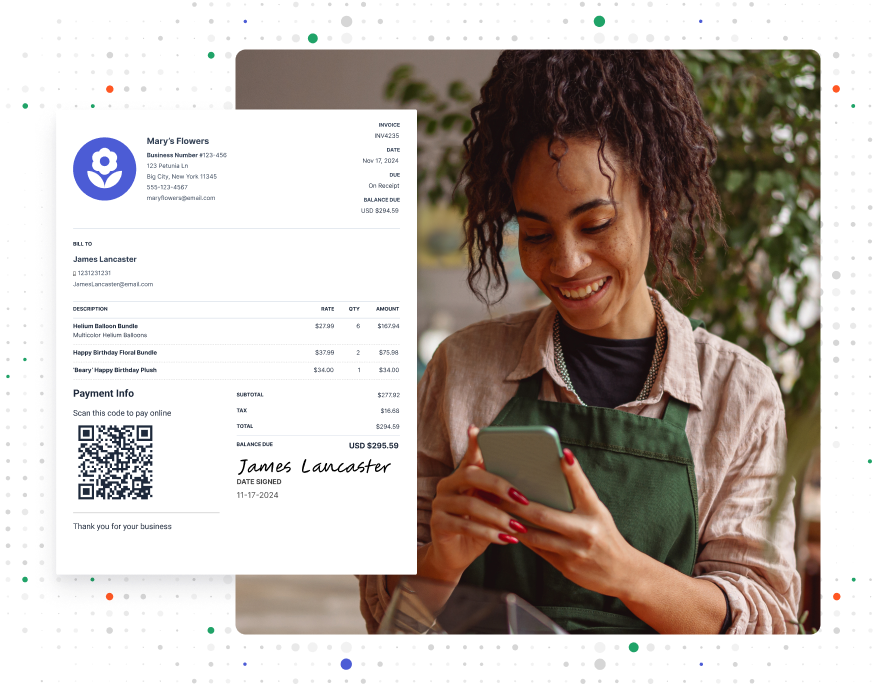9 Advantages of a Cashless Business

We’re not a cashless society today. However, with the rapid rise in digital and online payments over the past few years, cash is now a payment underdog. Fewer people use it. Also, fewer businesses accept it.
In fact, going completely cashless has a few noteworthy advantages for businesses. As a cashless business, you can simplify transactions, increase security, and reduce late payments.
If you’re thinking about going cashless, read on. This article explores the advantages of becoming a cashless business.

The Growing Importance of Cashless Transactions
Cashless transactions are payments made without hard currency. They can occur in person with a point-of-sale system or online.
Some of the most common types of cashless transactions are:
- Credit and debit cards
- Online payment providers like PayPal
- ACH transactions
- Mobile payments like Apple Pay and Google Pay
A cashless business doesn’t accept cash at all.
For example, many online retailers are already cashless because payments are made online. Many small service-based businesses, including solopreneurs and freelancers offering online services (such as graphic design, web design, and social media management), are also cashless or cashless-first.
But if you have the option to accept cash, should you?
The reality is we’re clearly moving in the cashless direction. In 2022, only 18% of all payments were cash. Compare that to just five years ago when cash accounted for 31% of payments.
A big reason for this shift is the pandemic. During 2020 and 2021, online payments skyrocketed, and more people started turning to cashless and contactless options, including mobile wallets and contactless cards.
Another issue: generational changes. Younger generations are more tech-savvy, with many not carrying cash regularly. So, they’re more inclined to pay for goods and services using newer payment technologies.
Gen Z and Millennials, for example, are far more likely to use their phones to make payments than Boomers. One consumer survey found that 18- to 24-year-olds are more than twice as likely as those aged 55+ to use a digital payment method for in-store transactions.
The bottom line is society is growing accustomed to cashless transactions. And a lot of business owners are responding to this shift by becoming cashless or cashless-first.
RELATED ARTICLE: The 6 Best Small Business Payment Options

9 Advantages of a Cashless Business
Going cashless can benefit your business and your clients. Here are nine advantages cashless businesses have:
1. More Secure Payments
Cashless payment methods such as ACH transactions and credit cards use encryption and other methods to secure payment information. Methods like digital wallets and online payment providers use PINs, passwords, and token-based authentication to protect access, keeping payment data safe.
2. Decreased Theft
There is a drop in theft and crime that comes with going cashless. That’s because there’s no way to rob your business’s cash on hand if you don’t have any.
3. Saved Time
Your business will save time without cash. No one has to count cash manually. And there are no trips to the bank to deposit money or to take out cash so you have change for your customers.
4. More Organized Record-Keeping
Digital payments generate an automatic record. This is great for improving your bookkeeping process. It’s also a win when it comes to avoiding mistakes. All your financial transactions are instantly recorded using your business payment software.
5. Improved Customer Experience
In-store, digital payments let customers tap and go.
Online, they can pay an invoice or bill with the click of a button.
With cashless payments, the process is faster and more streamlined for your customers. It’s also more convenient. There’s no need to carry cash. And they have the flexibility to pay using their preferred digital method, whether that’s a credit card, PayPal, or something else.
6. Fewer Late Payments
Nearly three-quarters of businesses are negatively impacted by late payments. With the simplicity and flexibility of cashless payments, your business can reduce late payments, helping to improve your cash flow.
7. Better Customer Insights
With cash payments, your business doesn’t have the opportunity to learn much about your customers.
But with cashless methods, there’s a lot to learn. Here are some examples:
- Preferred payment methods
- Seasonal payment trends
- The time it takes for an invoice received to be paid
8. Transactions Can Happen on the Go
Your customers can’t pay you on the go with cash. But they can with digital payment methods. For example, when you send an online invoice, they can review it, approve it, and pay all from a mobile device. This makes payments far easier for them.
9. More Future-Proof
Experts expect cash to account for less than 9% of point-of-sale transactions in 2024.
And as expectations for secure, convenient payments keep rising, businesses that are already cashless-first will have an edge. They are the ones offering the most advanced payment options. And they will already know what their customer base wants.
FROM ONE OF OUR PARTNERS: The Future of Online Payments: What You Need to Know

Cashless Business Digital Payment Methods
Cashless businesses can offer a lot of payment flexibility. But most importantly, you’ll be ready to align with evolving customer expectations.
A 2022 study found that 41% of Americans don’t use cash at all for their typical weekly purchases. Consumers who prefer cashless methods prize convenience, security, and simplicity.
There are plenty of cashless options. And once you’ve already adopted a system for accepting payments, it’s easy to add new digital payment methods.
Here are four options you can offer now as a cashless business:
- Contactless payments: These payments rely on RFID technology and near-field communication to transmit payment info. Customers use a card or another device, such as their smartphone, for a touch-free payment experience.
- Mobile wallets: Apple Pay, Samsung Pay, and Google Pay are all types of mobile wallets. Payment information is stored securely on a smartphone, smartwatch, or another device. Mobile wallets let people pay online or in-store.
- ACH payments: These are electronic bank-to-bank transfers. If you invoice your clients, offering ACH payments is great because of the low transaction fee.
- Cryptocurrency: Crypto payments still make up a small fraction of transactions. However, they are growing. Crypto payment transactions are expected to grow at a compound annual growth rate of nearly 17% from 2022 to 2029.
FROM ONE OF OUR PARTNERS: How Does Mobile Payment Processing Work?
Top Takeaway Tips for Adopting a Cashless Business
The more cashless your business is, the more ready you are for the future of payments. So, what are you waiting for? You can start making your move today.
Here are three tips that can help you start integrating cashless systems into your business right now:
- Create a payment survey. What are your customers’ favorite ways to pay? Send a quick survey by email to find out.
- Offer a cashless discount. Help your customers get ready for cashless by encouraging them to use digital payments.
- Choose a payment software. Once you pick your invoicing software or payment processor, you can start accepting your customers’ preferred cashless methods.
Start Your First
Invoice Today
Create customized and professional
invoices and connect with clients
